Let’s get our geek on and learn about history and math on this Pi Day with a special Medieval Cornish Bacon Egg Pye recipe.
Did you know that March 14th is Pi Day? And in 2016 it is also Pi rounded up to exactly 4 decimal points – 3.1416. OK math lesson is over but it is a great excuse to make pie! And our pie will travel back in time as well. I write a lot about recipes from different parts of the world, but today we will try something a little something different and explore another time. History has a lot to offer when it comes to culinary discoveries. This time machine trip will take us to Europe during the Middle Ages where we will explore how people ate, such as this 15th century Cornish Bacon Egg Pye.
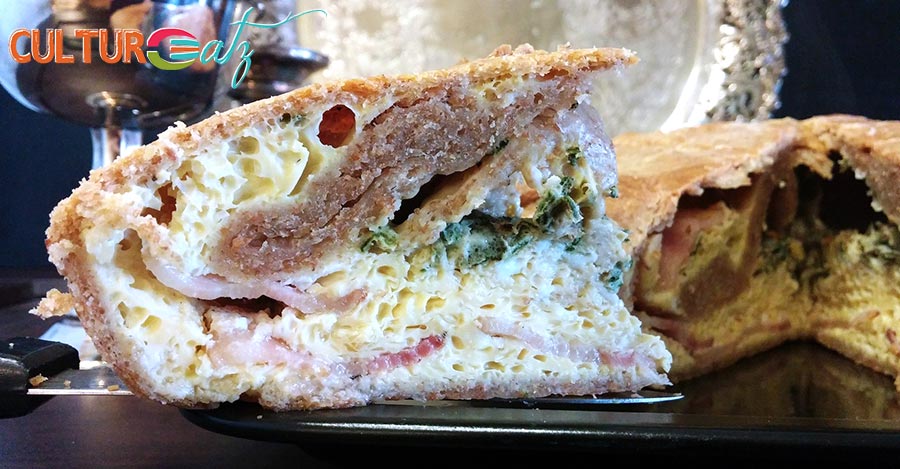
When was the Middle Ages again?
Before we explore the foods and dishes of that time, let’s define the Middle Ages. Medieval time covers roughly the 5th to the 15th century. It is called the Middle Ages because it is the middle period of the three main divisions of history, at least the Western one: first is Antiquity which ends with the collapse of the Roman Empire, second is the Medieval period, and third we have the Modern period which started with the Renaissance.
The Middles Ages are also sometimes referred to as the Dark ages, aka intellectual darkness. We just did not accomplish much a the human race. Thankfully we saw the light eventually 🙂
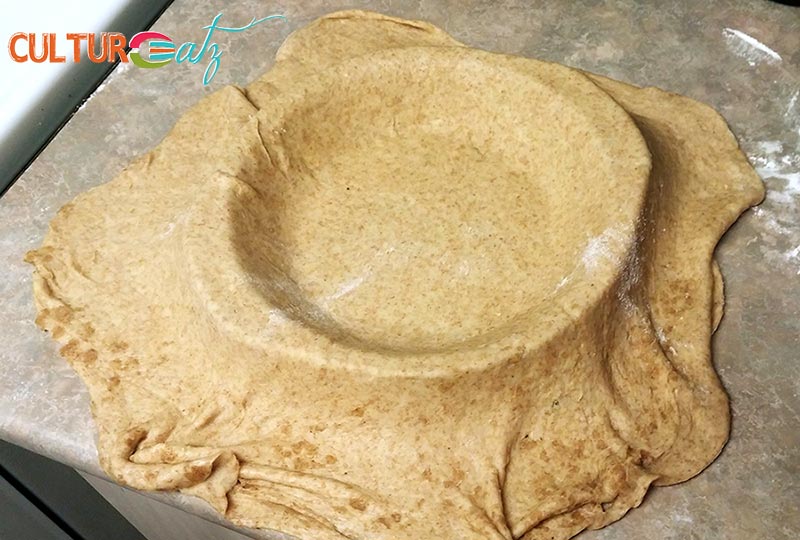
And what did we eat in Medieval time?
Now that we have a clear idea of our time frame we can understand better how we ate. Farming is at the top of the list and our biggest crops are cereals, with which we make bread. Everybody eats bread, it’s the staple, some survive on it. Barley, oat and rye is for the poor, whereas wheat is for the rich and high placed folks. Cereals could also be prepared a porridge, gruel and pasta.
We can also grow some fruits and vegetables, like cabbage, beets, onions, garlic, carrots, apples, pears, plums, and strawberries. We have already started exporting and import finer fruits – like oranges, dates and figs – but only the rich can afford them. Fruit was often mixed with meat, fish and eggs.
Only the nobility and wealthy can afford wild game meat. Forget raising cows, that is way to expensive, so we stick to hunting. Fishing is a bit more accessible to all so we enjoy the occasional cod, herring and other freshwater fishes. In part 2 of our Medieval culinary exploration I will discuss seasonings, so keep an eye out for that future post.
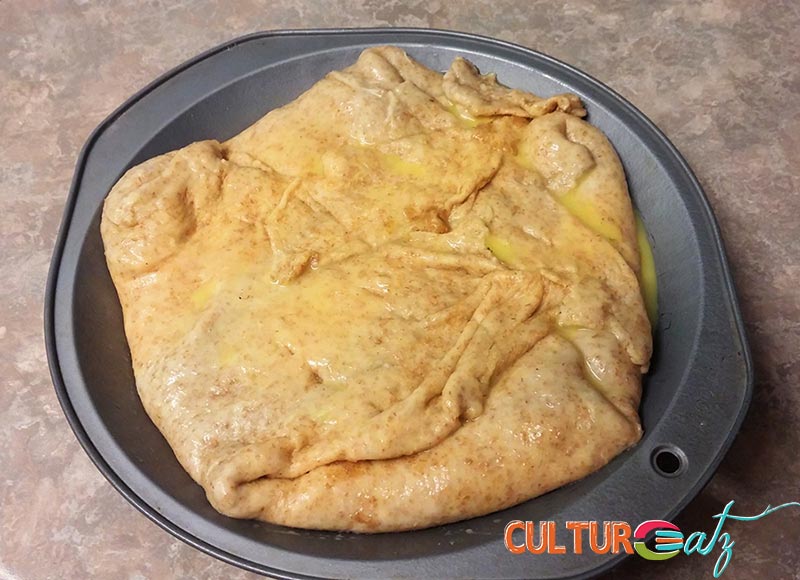
I want by boar steak to go please!
At this point in history we have a clear idea about how to prepare and cook our food. Most of the cooking is done over a fire. The stove in a home comes later in history, sometime in the 18th century. There were however large communal stoves, often run by the baker.
The concept of pastry starts taking shape but at first dough is used primarily as a hard, inedible container. Without refrigeration or tupperware, pastry is the perfect portable device to carry food around. Can you believe lots of pastry recipes have the word “coffyn” in the title at this time! Pastry only becomes edible, or part of the dish, around the 15th century.
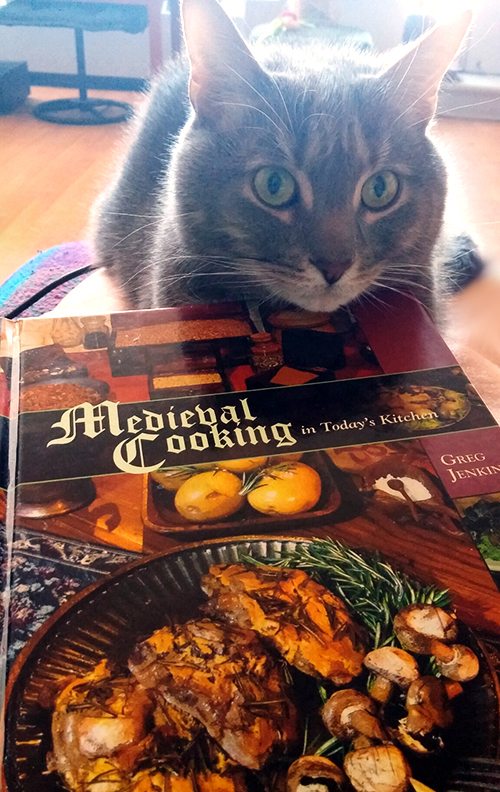
The Cornish Bacon Egg Pye recipe I have for you today is totally edible as it this version comes from Cornwall, England, during the 15th century. Earlier version are said to date back to Briton in the Dark Ages, and it is probably a predecessor to the French quiche (minus the cheese and no upper crust). The Cornish Bacon Egg Pye recipe is excerpted from the Medieval Cooking in Today’s Kitchen cookbook, courtesy of Schiffer Publishing. As you can see, one of my cats, Miyu, is quite fond of the book too.
It’s one of the most unusual cookbooks I have ever read. The author is a scholar with a passion for the Middle Ages. The first part is practically a thesis on the matter but a really good read. Loved the ‘cocktail’ section but most recipe leveled at a gallon of libations. I recommend you check it out if you want more Medieval recipes. It’s not a flashy book with killer pics but the recipes are really authentic. I will post a really fun almond soup recipe in Part 2 that I truly enjoyed.
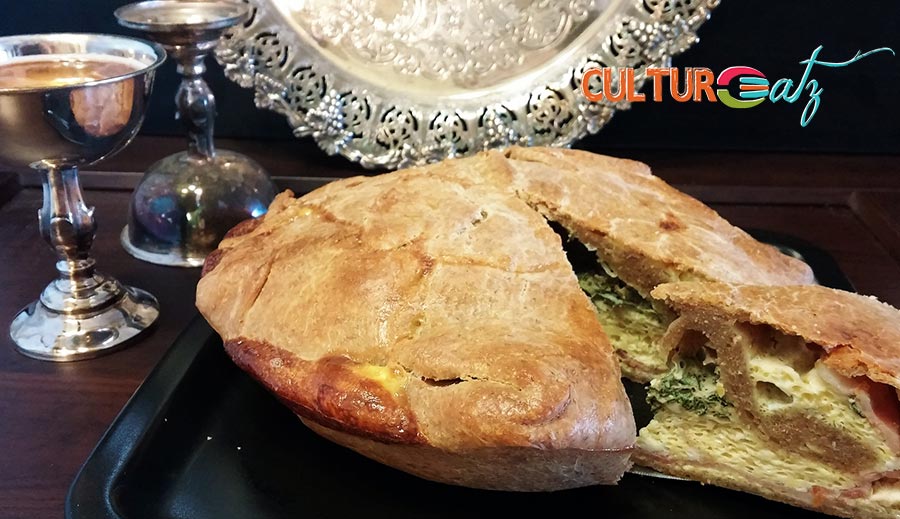
I am sure you had a double take at my first photo of the dough stretched over the pie plate. This pastry dough is the weirdest I have ever made. I have never seen such an elastic and form fitting dough, it was amazing to work with. This dough is a real scientific experiment in seeing the power of gluten! It’s OK if the dough is kinda wet prior to putting it in the fridge overnight. Adding too much flour will make the dough tough.
Once you have you dough layered out just top it with slices of bacon and your egg mixture. Then clumsily flip the rest of the dough over to cover the top. It is not going to look pretty. But while the Cornish Bacon Egg Pye a pretty yet robust pie shape takes hold. The taste was really good and a nice slice is quite filling. It would go so well with a pint of ale! If you plan on making this for guest, plan of serving the pie as soon as it comes out of the oven. Leftovers will fall flat as the egg mixture deflates, like a souflee.
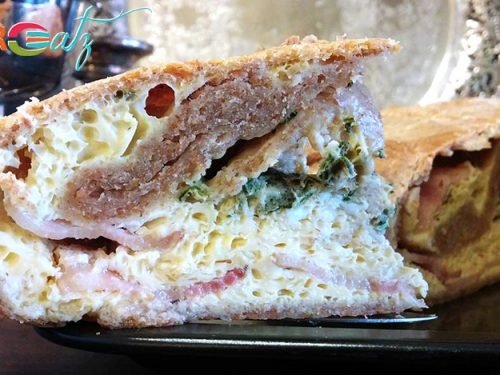
Cornish Bacon and Egg Pye
Ingredients
For the pastry:
- 2 cups flour
- 2 eggs
- 1/2 cup vegetable oil
- 1/2 cup water
- 1 teaspoon salt
- 1 egg yolk
For the filling:
- 6 rashers of bacon cut into pieces
- 2 to 4 sprigs of parsley chopped fine
- 5 eggs
- 1/4 pint milk
- 3 sprigs fresh sage chopped fine
- salt and pepper to taste
Instructions
- Preheat oven to 400 degrees F.
- To make the pie crust, mix the flour, eggs, salt, oil, and water in a bowl until the mixture holds together. Add more water or flour if necessary. Form into a ball, cover with wax paper, and refrigerate overnight.
- Roll out the dough as thin as possible on a floured cutting board. You can use a large pie pan or small, individual pie pans. Place the dough into a greased pan, lay the bacon on top, and dust with the parsley.
- In a separate bowl, beat the eggs and milk and pour over the dough and bacon, then season with sage, salt, and pepper. Cover with the remaining dough and press the edges with a fork.
- Cut slits on the top to vent steam. Brush with the egg yolk and bake for 40 minutes.
The cookbook featured in this post was provided to me free of cost for review. Any personal opinions reflected in this post are my own and without influence.




Great insight into medieval cooking! Thanks for sharing!
Thanks Eileen for stopping by!
I have decided I want to come and live with you, your food looks CRAZY delicious. 🙂
Its a long, long weekend here this weekend, going to get my chef on and have a go at your pie. Yarm!
I will most definitely make room for you with that awesome compliment Anna, come on over!Let me know how it turns out!
Wow, what an historical journey. And the dough really does look amazing.
Thanks Serina for stopping by! yes the dough was fun.
This would be great for breakfast. Ill see if i have time tomorrow to make it.
Gary, I can confirm it is excellent for breakfast 😀
Loved the medieval history to the pie!
Thanks Rosemarie 🙂
What an interesting blog post and idea to make a pye. It looks delicious despite being a little “weird” to prepare. So good to read about the food from the middle ages. Thanks for such an informative post.
My pleasure Rosemary glad you enjoyed the post and learned medieval food facts! Yep a bit weird to make indeed lol.
How fun!! I’m a medieval enactor and I love learning about medieval foods. This sounds marvelous. 🙂
That is so cool Krista that you are a medieval enactor, keep an eye out for my next post then!
I love the idea of a bacon and egg pie! And that dough is amazing!
Yeah I don’t know if it was a fluke or the dough is always like that lol. If you try, I used whole wheat and put a bit less in.
What a great post Evelyne. Thanks for sharing this interesting info.
Thank you so much Wendy for you comment 🙂
I absolutely loved the history lesson behind this Eve! I learnt so much. And now I’m hungry for pie 😀
Thanks Lorraine, glad you loved the history lesson and pie 😀
It is always interesting to learn the eating habits of our ancestors. This pie looks absolutely delicious!
Thank you Katerina, I learn always so much from you, nice to return the favor this time 🙂
Holy Crap! WHAT IN THE WHAT?! I really think you and I would have WAYYYYYYYYY too much fun in the kitchen and we would eat our body weight in…. MEAT! YES!! Come ON OVER!
It’s a deal! but can we meet halfway lol?
Holy moly… what a mouthwatering pie. I’d like to share it with no one. 🙂
Thanks Denise, and who says I did hi hi 😉
Great post! Thanks for the history lesson! What a gorgeously looking pie! I love it! Especially because of bacon and egg. YUM!
Thanks Nagi, yep bacon is always a winner! Glad you loved the history lesson!
Thanks for the history lesson :). Such a nice recipe and you encouraged me to try this weird dough. What the poor ate oats,rye and not much of red meat!!! I bet they lived healthier than the rich :))). Miyu looks so interested I bet she/he helps in the cooking.
Ha if you try the dough Amira let me know what you think of it! Glad you like the post and info. Miyu is better at trying to eat food than help ha ha 🙂
REALLY fun post! Thoroughly enjoyed it. Did you ever read 1066 and All That? You’d love it. Anyway, terrific pi. Pie. Whatever. 🙂
It’s pye John 😉 hi hi. So glad you enjoyed the post as much as you did. Look out for part 2. And I will have to check out that reading suggestion.
This is really interesting, Evelyne. I always learn something new from you. A wonderfully delicious savoury pye!
Thank you Angie, glad you liked the pye and enjoyed the post 🙂
This part was really interesting and informative. I think I would enjoy the recipe book ?
Thanks Tandy glad you liked all the Medieval food information. It is fun book for sure.
The first photo is food porn. What a scrumptious looking pie! And who woudn’t LOVE bacon and egg encased in pastry!
Ha ha thanks! And yes I wish I had some breakfast right now!